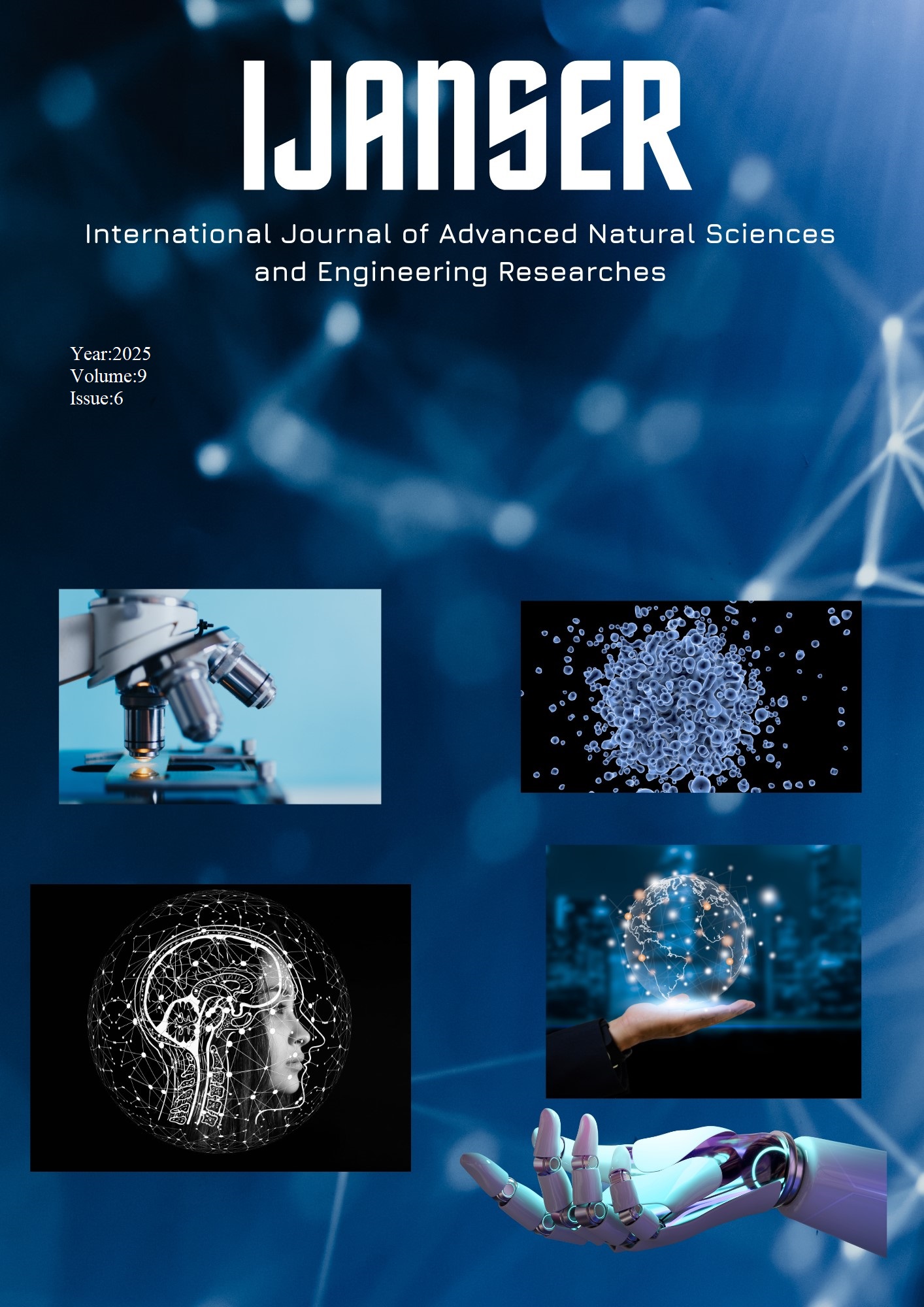FEM-Based Numerical Analysis of a Shielded Interdigitated Capacitive Humidity Sensor
Keywords:
Humidity Sensor, Capacitive Sensor, Interdigitated Electrodes, Polymer Dielectric, ANSYS Maxwell, Numerical Analysis, FEM SimulationAbstract
This study focuses on analyzing the humidity-dependent capacitive behavior of the sensor, driven
by a polymer dielectric layer whose permittivity is modulated by ambient relative humidity (RH). The
sensor's intricate architecture was meticulously modeled in 3D, incorporating a silicon substrate, copper
shielding layers, a silicon dioxide dielectric, and interdigitated copper electrodes embedded within the
humidity-sensitive polymer. The simulation methodology involved an electrostatic analysis with a 1 V
excitation applied to one set of interdigitated electrodes, while the other set and the shielding layers were
grounded to define the electric field. To systematically evaluate performance, a parametric sweep was
executed for RH, ranging from 0% to 100%. The principal results demonstrate a clear and highly linear
correlation between the sensor's capacitance magnitude and the RH, with an approximate change from 707
pF at 0% RH to 767 pF at 100% RH. This translates to a calculated sensitivity of approximately 0.6
pF/%RH, indicating effective detection of humidity variations. Furthermore, detailed field analyses of
electric field intensity, electric flux density, electrostatic potential, and stored energy density, visualized
across sensor surfaces and along a defined polyline, consistently confirmed the strategic concentration of
electric fields within the inter-electrode gaps. These findings validate the active sensing mechanism and
underscore the efficacy of the shielding layers in enhancing measurement stability. In conclusion, this
numerical investigation confirms the robust performance and design feasibility of the proposed shielded
interdigitated capacitive sensor for accurate and reliable humidity sensing applications.
Downloads
References
J. He et al., “High Performance Humidity Fluctuation Sensor for Wearable Devices via a Bioinspired Atomic-Precise Tunable Graphene-Polymer Heterogeneous Sensing Junction,” Chem. Mater., vol. 30, no. 13, pp. 4343–4354, Jul. 2018, doi: 10.1021/acs.chemmater.8b01587.
M. A. Najeeb, Z. Ahmad, and R. A. Shakoor, “Organic Thin‐Film Capacitive and Resistive Humidity Sensors: A Focus Review,” Adv. Mater. Interfaces, vol. 5, no. 21, Nov. 2018, doi: 10.1002/admi.201800969.
A. H. Assen, O. Yassine, O. Shekhah, M. Eddaoudi, and K. N. Salama, “MOFs for the Sensitive Detection of Ammonia: Deployment of fcu-MOF Thin Films as Effective Chemical Capacitive Sensors,” ACS Sensors, vol. 2, no. 9, pp. 1294–1301, Sep. 2017, doi: 10.1021/acssensors.7b00304.
M. A. Andrés et al., “Methanol and Humidity Capacitive Sensors Based on Thin Films of MOF Nanoparticles,” ACS Appl. Mater. Interfaces, vol. 12, no. 3, pp. 4155–4162, Jan. 2020, doi: 10.1021/acsami.9b20763.
C. Sapsanis et al., “Insights on Capacitive Interdigitated Electrodes Coated with MOF Thin Films: Humidity and VOCs Sensing as a Case Study,” Sensors, vol. 15, no. 8, pp. 18153–18166, Jul. 2015, doi: 10.3390/s150818153.
T. Islam, A. T. Nimal, U. Mittal, and M. U. Sharma, “A micro interdigitated thin film metal oxide capacitive sensor for measuring moisture in the range of 175–625 ppm,” Sensors Actuators B Chem., vol. 221, pp. 357–364, Dec. 2015, doi: 10.1016/j.snb.2015.06.101.
K. Narimani, F. D. Nayeri, M. Kolahdouz, and P. Ebrahimi, “Fabrication, modeling and simulation of high sensitivity capacitive humidity sensors based on ZnO nanorods,” Sensors Actuators B Chem., vol. 224, pp. 338–343, Mar. 2016, doi: 10.1016/j.snb.2015.10.012.
Z. Wu et al., “Development of a rGO-BiVO 4 Heterojunction Humidity Sensor with Boosted Performance,” ACS Appl. Mater. Interfaces, vol. 13, no. 23, pp. 27188–27199, Jun. 2021, doi: 10.1021/acsami.1c05753.
S. Küçükdermenci, “Hedeflemeli Manyetik Hipertermi için Alansız Bölge OluşturmaYöntemlerinin FEM Simulasyonu ile Karşılaştırılması [Not available in English],” in 2019 3rd International Symposium on Multidisciplinary Studies and Innovative Technologies (ISMSIT), IEEE, 2019, pp. 1–6.
S. Küçükdermenci, “Manyetik sıvı hipertermi için parametrik olarak üretilen gradyan örüntülerinin haritalanması,” Düzce Üniversitesi Bilim ve Teknol. Derg., vol. 9, no. 3, pp. 121–129, 2021.
S. Küçükdermenci, “Symmetric/asymmetric positioning of a permanent magnet pair for selective magnetic hyperthermia,” Kuwait J. Sci., 2021.
S. Küçükdermenci, “Investigation of field free region formed by dual Halbach array for focused magnetic hyperthermia,” J. Electr. Eng., vol. 73, no. 2, pp. 152–157, Apr. 2022, doi: 10.2478/jee-2022-0020.
S. Küçükdermenci, “Mapping of Gradient Patterns Generated with Helmholtz Coils for Localized Magnetic Fluid Hyperthermia,” Kocaeli J. Sci. Eng., vol. 5, no. 2, pp. 159–166, 2022.
S. Küçükdermenci, “Analysis of field-free region formed by parametric positioning of a magnet pair for targeted magnetic hyperthermia,” Kuwait J. Sci., vol. 49, no. 4, 2022.
S. Küçükdermenci, “Hedeflemeli manyetik hipertermi için tek ve çift eksen konumlamalarla oluşturulan gradyan desenlerinin haritalanarak incelenmesi,” Gazi Üniversitesi Mühendislik Mimar. Fakültesi Derg., vol. 38, no. 1, pp. 571–578, 2023.
S. Küçükdermenci, “Investigation of gradient pattern maps generated with single and dual axis positioning for targeted magnetic hyperthermia,” J. Fac. Eng. Archit. Gazi Univ., vol. 38, no. 1, pp. 571–578, 2023.
S. Küçükdermenci, “Dual Magnet Arrays For Spatial Targeting of Magnetic Particle Hyperthermia,” in 2nd International Conference on Innovative Academic Studies ICIAS 2023, 2023.
S. Küçükdermenci, “Numerical Comparison of Active Shielding Techniques for Magnetic Fluid Hyperthermia Application,” in International Conference on Applied Engineering and Natural Sciences, Jul. 2023, pp. 879–888. doi: 10.59287/icaens.1105.
H. Farahani, R. Wagiran, and M. Hamidon, “Humidity Sensors Principle, Mechanism, and Fabrication Technologies: A Comprehensive Review,” Sensors, vol. 14, no. 5, pp. 7881–7939, Apr. 2014, doi: 10.3390/s140507881.
J. Wu et al., “Carbon Nanocoil-Based Fast-Response and Flexible Humidity Sensor for Multifunctional Applications,” ACS Appl. Mater. Interfaces, vol. 11, no. 4, pp. 4242–4251, Jan. 2019, doi: 10.1021/acsami.8b18599.
S. Li et al., “Humidity-sensitive chemoelectric flexible sensors based on metal-air redox reaction for health management,” Nat. Commun., vol. 13, no. 1, p. 5416, Sep. 2022, doi: 10.1038/s41467-022-33133-y.
W. Xuan et al., “Fast Response and High Sensitivity ZnO/glass Surface Acoustic Wave Humidity Sensors Using Graphene Oxide Sensing Layer,” Sci. Rep., vol. 4, no. 1, p. 7206, Nov. 2014, doi: 10.1038/srep07206.





